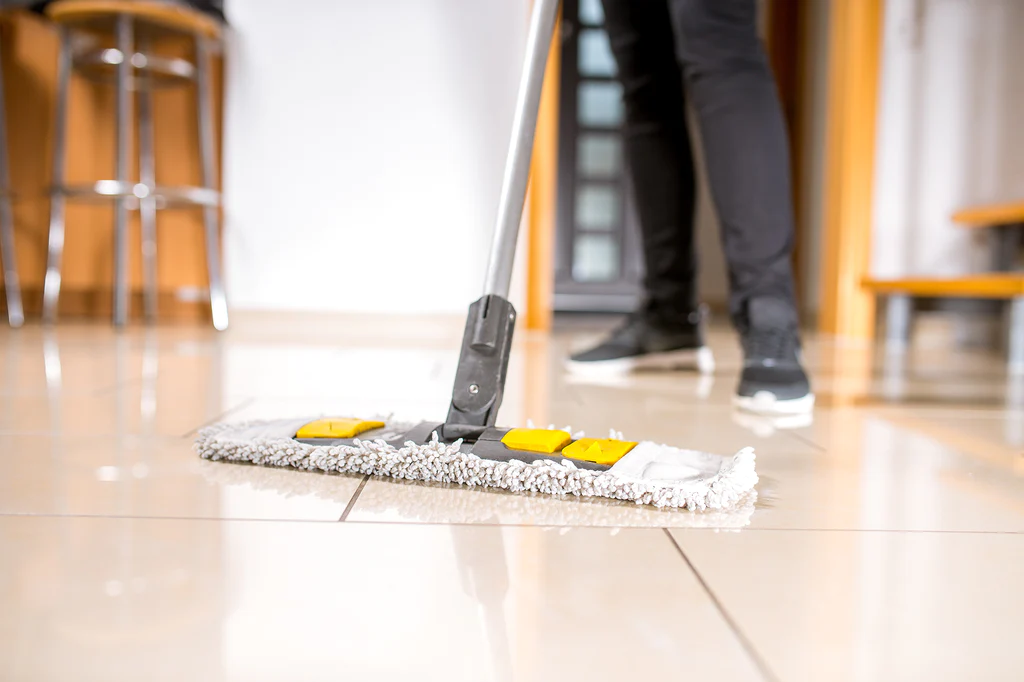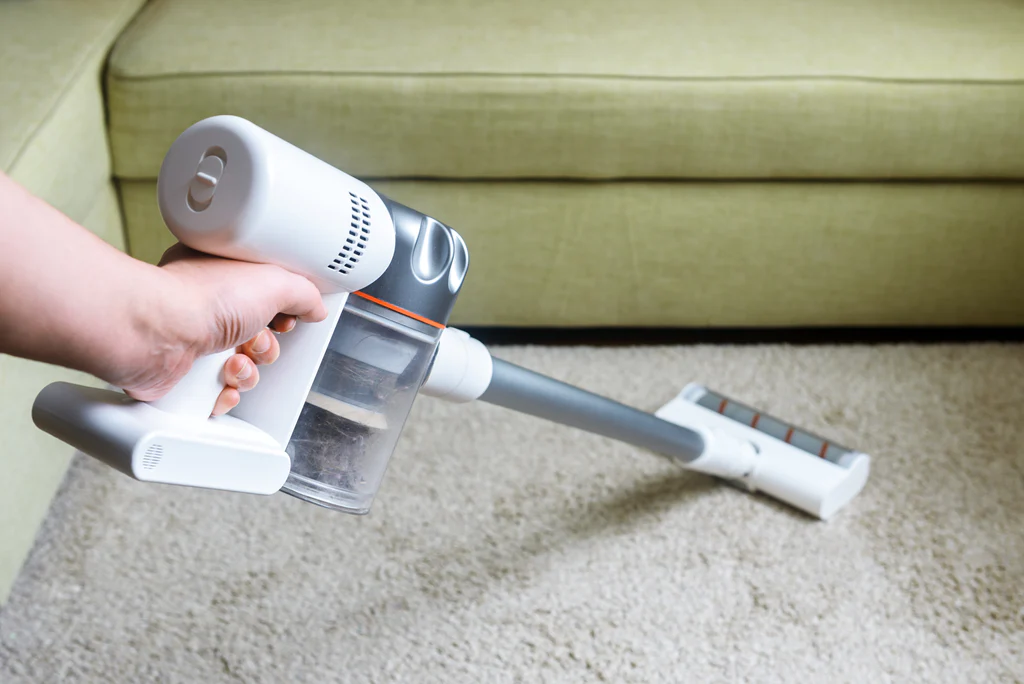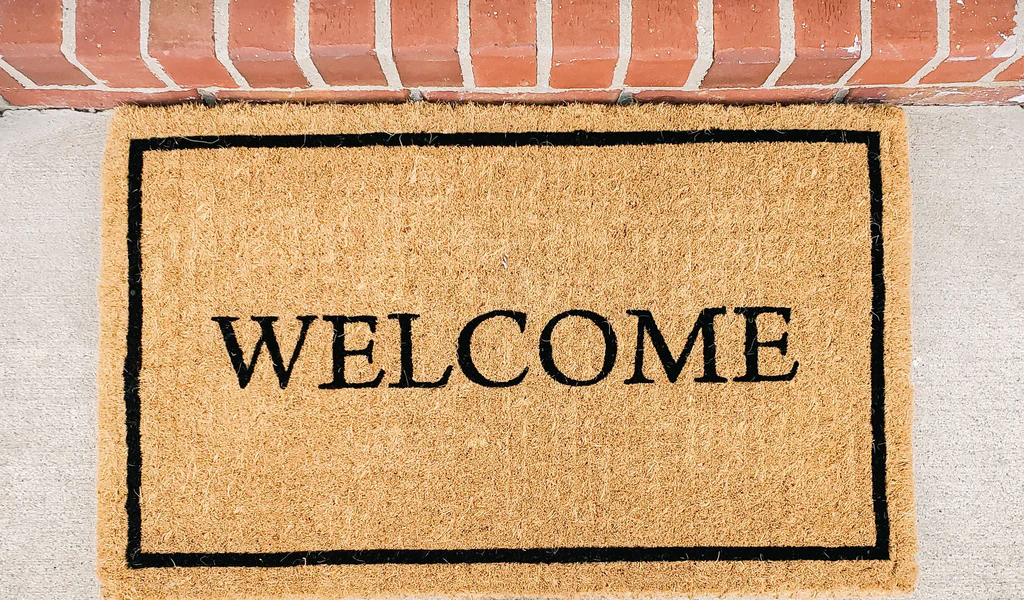Correct Ways To Clean Floors
Between whatever you track in on your shoes, crumbs accidentally dropped from the kitchen table, the natural accumulation of dust, and so on, the floors in your home can get quite grimy. But a little maintenance goes a long way—especially if you attack that grime in the most efficient manner for every type of floor. Whether your home is mostly hardwood, carpet, tile, or stone—or even a mix of all four—we’ll teach you how to properly clean them.
For most surfaces, it is important to sweep, vacuum, and mop your floors to remove any dirt and dust that has collected on the floor. It’s easy to tell when your floor needs to be cleaned by simply looking at it… or by checking the bottom of your feet after walking around your house barefoot. But how to clean your floors, and how frequently you should give them a good wash, depends on a multitude of factors.
Sweep + Vacuum + Mop
Sweeping
Sweep high-traffic areas, daily or every other day if you can. And especially when cooking a lot to make sure food and other debris doesn’t get kicked around and scratch up the floors. Lower traffic areas will need to be swept around twice a week. If you skip this step, the next step (mopping) will be entirely pointless and you’ll just be pushing wet dirt, dust, hair, and fur around into wet tiny clumps.
Pick up any rugs, chairs, and other obstacles off of the floor to make sure you remove all debris. Start in one corner (the one that is the longest distance from the doorway) and work toward that exit. Divide the room up into 4 sections, and sweep each using short and deliberate strokes. Keep the pile of swept dirt in each section, creating a new dirt pile in each section. Don’t move the dirt pile around, as this will make the floor dirtier. Sweep up the dirt pile from each section once you have finished sweeping the room. If the dustpan leaves behind a small line of dirt, use a damp paper towel to wipe it up. Clean your broom from time to time. A clean broom is key to making sure that it will actually clean the floor, rather than add more dirt to it.
Vacuuming
Vacuum high traffic areas at least 3 times per week. Kitchens and living rooms require regular vacuuming, and this will increase as the number of people living in the house rises. Lower traffic areas such as bedrooms should be vacuumed once a week. As a general rule of thumb, vacuum an area as many times per week as the number of people that use that space. For example, a 1-person bedroom can be vacuumed weekly. However, a living area with 4 people should be done 4 times per week.
- You will need to vacuum more often if you have a pet that sheds fur or a child with allergies.
- Move all of the small furniture out of the room once a month, so that you can vacuum the floor beneath it as part of a deeper cleaning routine.
- Move all of the large furniture out of the room to vacuum beneath it once or twice a year.
Start by vacuuming the whole room in one direction, and then vacuum the space again at a right angle. This will make sure you are cleaning thoroughly, and that the vacuum picks up at much debris as possible.
- Vacuum the whole floor twice if it is a high traffic area.
- Make sure that you area vacuuming slowly so that the machine has a chance to be effective. This will make lifting up pet hair faster, as you won’t need to do as many strokes.
Mopping
In general, it is best to clean your floors every one to two weeks. Mop high-traffic areas like the kitchen once a week; for less-trafficked areas, mop once or twice a month. This helps to keep on top of any grime that is building up, and particularly to keep kitchens and bathrooms clean. Areas that aren’t used frequently can be mopped once every two weeks. It’s important to stick to only a small 3-4 ft. floor area at a time.
Get a classic, cotton mop. There are many more high tech and modern style mops out there, but this classic style works best. You can take the head off a cotton mop to put it in the washing machine, whereas a sponge or foamy mop will be much more difficult to clean.
The type of flooring you have also affects its cleaning method. Some mediums are more finicky to clean than others. Also, we encourage consumers to read labels before cleaning their floors to be sure you’re maintaining a clean home without dangerous chemicals.

Hardwood
Sealed hardwood floors are generally easy to keep clean, as there is nothing to trap dirt or dust. A simple sweep or vacuum should cover most messes. Stick to sweeping and mopping each week to keep the floor free of dust and scratching agents, only deep cleaning the floor as needed. This will prolong the life of your floor. Immediately wipe up any wet spills on hardwood floors. You should never leave moisture to sit around on hardwood floors. It can damage the seal and the wood permanently if you’re not careful. Wipe it up with a damp cloth, then dry the surface completely. Avoid using abrasive cleaning supplies like scrubbing pads or hard bristle brushes to prevent scratches. Don’t use bleach, ammonia, abrasive cleaners, or anything that will leave a residue (ex. oil, furniture spray, wax). Not only will they damage the hardwood, but a few will even void the warranty on your floor. To deep clean your hardwood floors in one step, specific hardwood floor cleaners, of course, are your safest bet. Run a mop over the floor along with the grain of the wood, starting in the farthest corner and working towards a door so you never have to step on wet floors. Spot-clean tough areas with a cloth. Apply cleaning solution to the cloth and scrub it over stains with your hands to apply a more directed pressure.
If you have unsealed wood floors, you’re off the hook—sort of. Since this type of flooring can be damaged by even small amounts of water, keep damp mops away from this surface, and instead sweep, dust mop, or vacuum regularly.
Laminate
Your laminate may resemble hardwood planks, but you still need to care for it as a laminate. The good news: Very few things will harm a laminate floor, says Bill Dearing, president of the North American Laminate Flooring Association. The planks are constructed in sun- and light-resistant layers to maintain a like-new appearance for years. That said, it’s important to keep water from getting underneath the planks. Laminate floors need to be cleaned regularly in order to prevent them from getting scratched or warped, but using harsh cleansers can create streaks or damage the laminate. General cleaning with a dry dust mop should be done every few days to remove everyday dirt, but for more intense cleaning, warm water or mild cleaners (labeled for use on laminate flooring) can also be applied. Sweep in the direction that the laminate floor tiles were laid. Doing so allows you to pick up any debris that falls in between the grooves of the laminate flooring pieces. Spot-clean with a slightly damp mop when necessary. Avoid using cleaners that promise to create a shiny surface, as these products can cause a waxy buildup on your floors. Similarly, don’t use pine scented products on your laminate floors, as they may leave a dull, soapy residue. And never polish a laminate floor. If the finish of a plank looks damaged, it’s best to replace it.
Stone
Avoid bleach, vinegar or ammonia so you don’t accidentally remove any sealant from your tile.
Instead, mop sealed stone floors with a pH-neutral, non-chelating cleaner that won’t react adversely to the minerals in natural surfaces. If your stone tiles are unsealed, simply mop with a microfiber mop and hot water; chemicals would penetrate the stone. For stubborn dirt, use a steam cleaner.

Ceramic and Porcelain Tile
For weekly cleaning, use a spritz-and-dry mop technique to keep tile floors looking fresh. Spray the floor one section at a time and wipe with a damp microfiber mop as you go. For periodic deep cleans, use a steam cleaner to clean both tile and grout—the steam does the work of removing stains (and bacteria!), so you don’t feel like you got an extra workout right there in your kitchen. You can also help keep tile floors from getting dirty as quickly by placing area rugs or mats in high traffic areas. This will ensure dirt sticks to the rugs and is not tracked across the tile.
Linoleum
As with other hard floors, the first step is to vacuum, sweep, or use a dry microfiber mop to pick up any dirt, hair, and dust. In high-traffic areas, do this daily or every other day if you can bear it. For a deep clean, treat this resilient, natural flooring as you would cork: Mix up a spray bottle of just a few drops of dish soap and hot water, then spritz a section of the floor at a time and wipe with a damp microfiber mop. Make sure the mop is damp and not dripping wet, since standing water can damage linoleum. The floor should air-dry almost immediately, but if it feels slightly sticky to the touch just swipe it with another clean, damp microfiber mop or cloth.
Vinyl
Like with hardwood floors, it is important to limit the amount of water and liquid cleaner on your vinyl floors. Excess water—even a little—can get into the seams of your vinyl floor and start to loosen the adhesive, which will cause the floor to peel. Regular sweeping and light mopping is the best way to keep this type of floor in shape.

Carpet
This part of your home is great at hiding dirt and debris. If you knew how many pounds (yes, pounds) of dirt were lurking in your carpets, you might think before you stepped. Wool rugs are particularly good at hiding dirt, and debris can damage the structure of the rug over time.
The most efficient way to clean medium to high pile carpet is with a turbo or electric power nozzle. Typically, both nozzles have a standard rotating roller brush that cleans deep into the carpet fibers. Figure out which direction the weaving goes in by petting the carpet, and make sure to vacuum with the grain, rather than against it (this can cause breakage).
For shag carpet, the deepest and most fail-proof possible clean is to borrow or rent a steam cleaner. But for regular, maintenance-type cleaning, you can use a straight suction floor nozzle and gently go over the rug. If your rug is small and you have some outdoor space, you can also take it outside, hang it up, and beat it with a broom handle to get rid of dirt and dust particles (as an added bonus, this is excellent for stress management).
Flatweave Rugs
Most flatweave rugs can withstand regular vacuuming on the front and back of the rug — check the care label or ask the manufacturer if you’re not sure. For delicate rugs, vacuum in small sections using a floor head with little to no agitation. To tackle spills, spot cleaning is your best bet. Blot wet stains with a paper towel (and do not rub them, since this can cause the stain to bleed or set in). For tougher stains, spot clean using a mild detergent mixed with hot water.
Pet Related Cleaning
Whether you’re cleaning carpet, wood, or tile, when it’s a pet-related stain you’re tackling, you want to use the right type of product that actually breaks down pet stains instead of simply covering them up with fragrance. Just be sure to test for safety in an inconspicuous area of your floor first.

Prevention Tips
Remove Those Shoes
If you want to minimize the grunge and dirt that your floors accumulate, you might want to take on a “no-shoe” policy in your household. This policy is the perfect means to control, if not eliminate, the amount of dirt and grime that gets tracked into the home on a daily basis. The soles of our shoes provide the perfect surface, almost as if a magnetic, for dirt, dust, and grime.
Mats At The Door
In pretty much the same vein as the removal of shoes before entering the home is the use of doormats. Taking the time to place a good quality doormat at each entrance into your home will go a long, long way to helping trap any dirt, grimes, or germs before they can even begin to make their way into any part of your home.
As you can see, several simple and easy hacks can aid in the cleaning of your floors. You will soon have floors that sparkle and shine like when they were brand new in no time at all.
